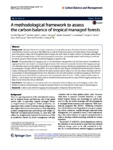Use este identificador para citar ou linkar para este item:
http://www.alice.cnptia.embrapa.br/alice/handle/doc/1051226Registro completo de metadados
| Campo DC | Valor | Idioma |
|---|---|---|
| dc.contributor.author | PIPONIOT, C. | pt_BR |
| dc.contributor.author | CABON, A. | pt_BR |
| dc.contributor.author | DESCROIX, L. | pt_BR |
| dc.contributor.author | DOURDAIN, A. | pt_BR |
| dc.contributor.author | MAZZEI, L. | pt_BR |
| dc.contributor.author | OULIAC, B. | pt_BR |
| dc.contributor.author | RUTISHAUSER, E. | pt_BR |
| dc.contributor.author | SIST, P. | pt_BR |
| dc.contributor.author | HÉRAULT, B. | pt_BR |
| dc.date.accessioned | 2016-08-18T11:11:11Z | pt_BR |
| dc.date.available | 2016-08-18T11:11:11Z | pt_BR |
| dc.date.created | 2016-08-18 | pt_BR |
| dc.date.issued | 2016 | pt_BR |
| dc.identifier.citation | Carbon Balance and Management, v. 11, n. 1, Dec. 2016. | pt_BR |
| dc.identifier.uri | http://www.alice.cnptia.embrapa.br/alice/handle/doc/1051226 | pt_BR |
| dc.description | Background: Managed forests are a major component of tropical landscapes. Production forests as designated by national forest services cover up to 400 million ha, i.e. half of the forested area in the humid tropics. Forest management thus plays a major role in the global carbon budget, but with a lack of unified method to estimate carbon fluxes from tropical managed forests. In this study we propose a new time- and spatially-explicit methodology to estimate the above-ground carbon budget of selective logging at regional scale. Results: The yearly balance of a logging unit, i.e. the elementary management unit of a forest estate, is modelled by aggregating three sub-models encompassing (i) emissions from extracted wood, (ii) emissions from logging damage and deforested areas and (iii) carbon storage from post-logging recovery. Models are parametrised and uncertainties are propagated through a MCMC algorithm. As a case study, we used 38 years of National Forest Inventories in French Guiana, northeastern Amazonia, to estimate the above-ground carbon balance (i.e. the net carbon exchange with the atmosphere) of selectively logged forests. Over this period, the net carbon balance of selective logging in the French Guianan Permanent Forest Estate is estimated to be comprised between 0.12 and 1.33 Tg C, with a median value of 0.64 Tg C. Uncertainties over the model could be diminished by improving the accuracy of both logging damage and large woody necromass decay submodels. Conclusions: We propose an innovating carbon accounting framework relying upon basic logging statistics. This flexible tool allows carbon budget of tropical managed forests to be estimated in a wide range of tropical regions | pt_BR |
| dc.language.iso | eng | eng |
| dc.rights | openAccess | eng |
| dc.subject | Selective logging | pt_BR |
| dc.subject | Error propagation | pt_BR |
| dc.subject | Production forests | pt_BR |
| dc.subject | Ciclo do carbono | pt_BR |
| dc.title | A methodological framework to assess the carbon balance of tropical managed forests. | pt_BR |
| dc.type | Artigo de periódico | pt_BR |
| dc.date.updated | 2016-08-19T11:11:11Z | pt_BR |
| dc.subject.thesagro | Floresta | pt_BR |
| dc.subject.nalthesaurus | Amazonia | pt_BR |
| dc.subject.nalthesaurus | carbon cycle | pt_BR |
| riaa.ainfo.id | 1051226 | pt_BR |
| riaa.ainfo.lastupdate | 2016-08-19 | pt_BR |
| dc.identifier.doi | 10.1186/s13021-016-0056-7 | pt_BR |
| dc.contributor.institution | Camille Piponiot, Université de la Guyane; Antoine Cabon, Centre Tecnològic Forestal de Catalunya; Laurent Descroix, ONF-Guyane, Réserve de Montabo; Aurélie Dourdain, CIRAD; LUCAS JOSE MAZZEI DE FREITAS, CPATU; Benjamin Ouliac, Guyane Energie Climat; Ervan Rutishauser, CarboForExpert; Plinio Sist, CIRAD; Bruno Hérault, CIRAD. | pt_BR |
| Aparece nas coleções: | Artigo em periódico indexado (CPATU)  | |
Arquivos associados a este item:
| Arquivo | Descrição | Tamanho | Formato | |
|---|---|---|---|---|
| 10.1186s1302101600567.pdf | 3,44 MB | Adobe PDF |  Visualizar/Abrir |









